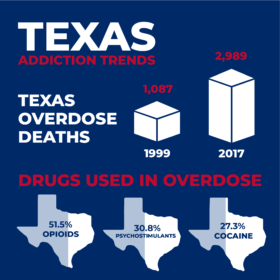By Beau Black
Recent studies paint a mixed picture of addiction trends in Texas. By many measures, the Lone Star State fares better than the rest of the nation, trailing the national averages and its surrounding states in illicit drug use and overdoses. But there are some troubling measures in the statistics, too — specifically in the significant increase in overdose deaths over the last two decades.
Current Abuse and Overdose Trends
The state as a whole “continues to have one of the lowest rates of drug overdose deaths involving opioids,” according to the National Institutes for Health (NIH)’s National Institute of Drug Abuse. Texas’ 5.1 deaths per 100,000 were just over a third of the nationwide figure of 14.6 deaths per 100,000 people.
Nationally, deaths related specifically to prescription opioids climbed to 15,000, the Centers for Medicare and Medicaid Services reported. Dispensed opioid prescriptions were down overall in Texas in 2017, according to the CDC, from 71.2 prescriptions per 100 people in 2007, to 53.1 in 2017.
Opioids include heroin, fentanyl (a synthetic pain reliever), and prescription pain medications like OxyContin and hydrocodone, according to the Centers For Disease Control(CDC). Nationally, opioids accounted for 47,600 of the 70,237 overdose deaths in 2017.
While there is good news in the statistics for the state, there are trouble spots as well.
Texas has a growing problem with overdose deaths, which totaled 2,989 for 2017, according to the CDC. As the Houston Chronicle reports, that number shows the state’s overdose rate nearly tripling, from 1999’s 1,087 deaths. Deaths related to fentanyl tripled over 10 years (2007-2017), and heroin overdoses doubled over the same period.
The opioid family still accounted for the majority of overdose deaths in the state: 51.5 percent. “Psychostimulants with abuse potential” accounted for 30.8 percent of such deaths, followed by cocaine (27.3%). Psychostimulant drugs include methamphetamine, Ritalin, MDMA, and ecstasy.
 How does Texas compare to other states?
How does Texas compare to other states?
Texas as a whole trailed its neighboring states significantly in all drug overdose deaths, the CDC found (measured in deaths per 100,000 people).
Here’s how those numbers stacked up:
- Texas – 10.5
- Arkansas – 15.5
- Oklahoma – 20.1
- Louisiana – 24.5
- New Mexico – 24.8
Perhaps more tellingly, Texas trails other, more comparable states with large populations: California saw 11.7 deaths per 100,000 people; New York saw 19.4 per 100,000 people. (At the top of the list: West Virginia, with an alarming 57.8 overdose deaths per 100,000.)
The National Survey on Drug Use and Health reveals that 10.7% of adults reported using marijuana within the last month, compared to 14.7 % for the nation. The same survey found 11.2% of adults nationwide reporting drug use within the last month; for Texas, the figure was 7.8%.
Those in the 18-25 age range admitted the highest drug use, with 17% of Texans 18-25 reporting use of any illicit drug in the last month, and 14.6 for marijuana specifically. (The numbers nationally for this age range are 23.7% for any illicit drug and 21.4% for marijuana.)
While these comparisons are positive for the state, a recent survey shows some concerning trends for the North Texas region. A North Texas Community Health Collaborative study of the 16 counties in North Texas found drug and alcohol death rates in Tarrant (Fort Worth) and Dallas counties well below the national average — but those rates for the surrounding counties were above the national average. This may be in part attributable to fewer available healthcare options in the rural counties. The study observed that “80% of the healthcare in the region is delivered in urban counties.”
The regional study also found the numbers of babies born suffering from the effects of their mothers using opioids were also higher in North Texas: “Nine out of every 1,000 babies born in North Texas suffered from drug toxicity, above CMS’ estimates for the rest of the US of six out of 1,000,” the study reports.
And though opioid prescriptions were down in the state as a whole, opioids were still the most prescribed medication in North Texas by a large margin: 4.8 million dispensed prescriptions, 3 million above the next group of drugs prescribed, according to the study.
Fortunately, there’s help available in Texas. If you or someone you love needs addiction treatment in the Lone Star State, The Meadows Texas offers inpatient programs that also address co-occurring conditions including depression, anxiety, and trauma. For those who don’t require residential care, The Meadows Outpatient Center-Dallas offers an Intensive Outpatient Program with day and evening options.

